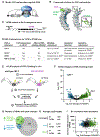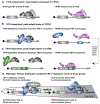PUF partner interactions at a conserved interface shape the RNA-binding landscape and cell fate in Caenorhabditis elegans
- PMID: 38290520
- PMCID: PMC11253550
- DOI: 10.1016/j.devcel.2024.01.005
PUF partner interactions at a conserved interface shape the RNA-binding landscape and cell fate in Caenorhabditis elegans
Abstract
Protein-RNA regulatory networks underpin much of biology. C. elegans FBF-2, a PUF-RNA-binding protein, binds over 1,000 RNAs to govern stem cells and differentiation. FBF-2 interacts with multiple protein partners via a key tyrosine, Y479. Here, we investigate the in vivo significance of partnerships using a Y479A mutant. Occupancy of the Y479A mutant protein increases or decreases at specific sites across the transcriptome, varying with RNAs. Germline development also changes in a specific fashion: Y479A abolishes one FBF-2 function-the sperm-to-oocyte cell fate switch. Y479A's effects on the regulation of one mRNA, gld-1, are critical to this fate change, though other network changes are also important. FBF-2 switches from repression to activation of gld-1 RNA, likely by distinct FBF-2 partnerships. The role of RNA-binding protein partnerships in governing RNA regulatory networks will likely extend broadly, as such partnerships pervade RNA controls in virtually all metazoan tissues and species.
Keywords: C. elegans; FBF-2; FBF-binding elements; PUF/PUM partner proteins; PUF/PUM-RNA-binding protein; RNA binding landscape; eCLIP; germline stem cells; gld-1 RNA; sperm/oocyte fate decision.
Copyright © 2024 The Authors. Published by Elsevier Inc. All rights reserved.
Conflict of interest statement
Declaration of interests The authors declare no competing interests.
Figures







References
Publication types
MeSH terms
Substances
Grants and funding
LinkOut - more resources
Full Text Sources
Molecular Biology Databases
Research Materials
Miscellaneous

